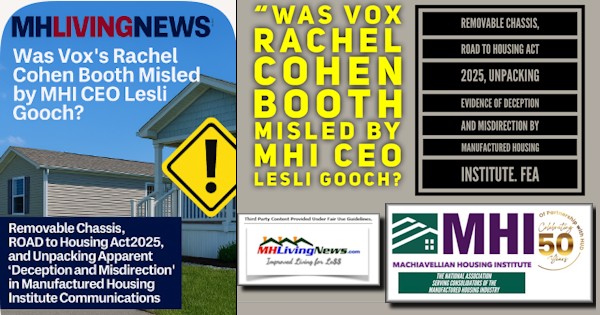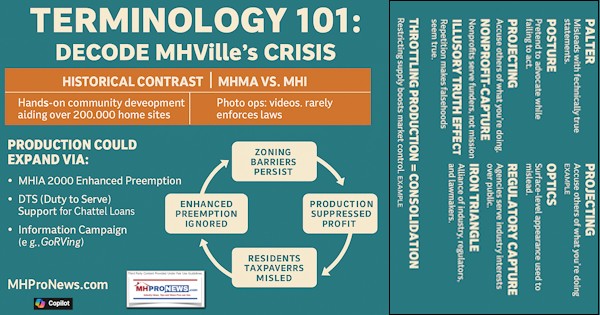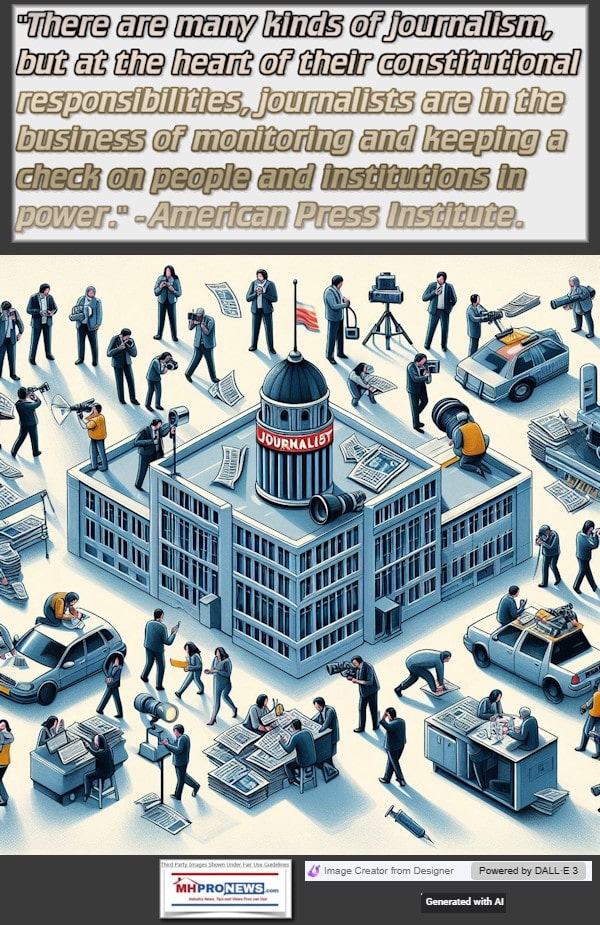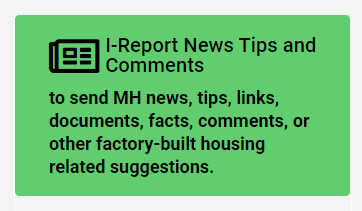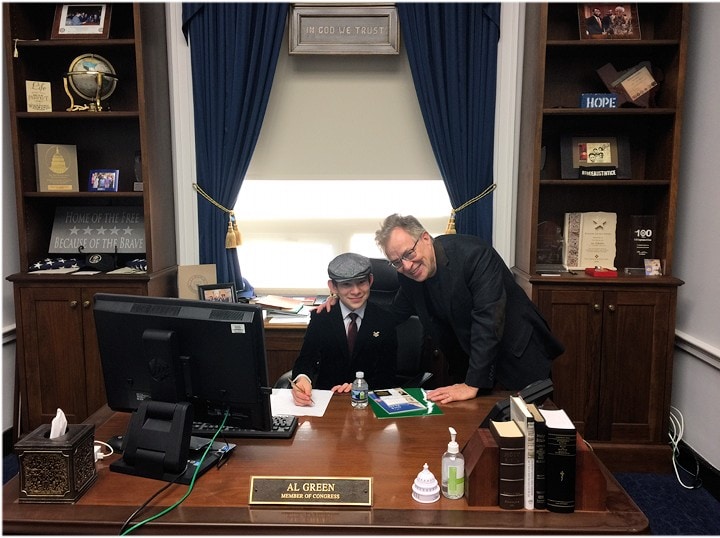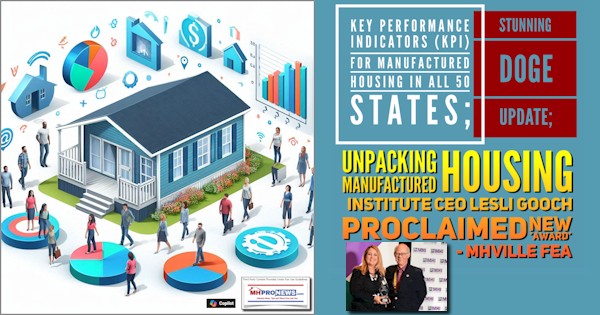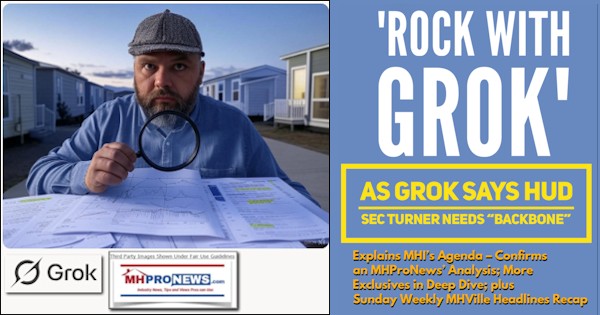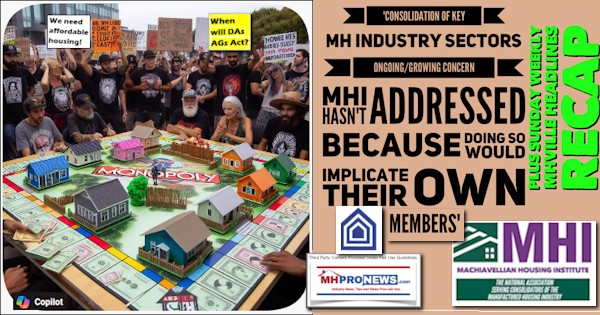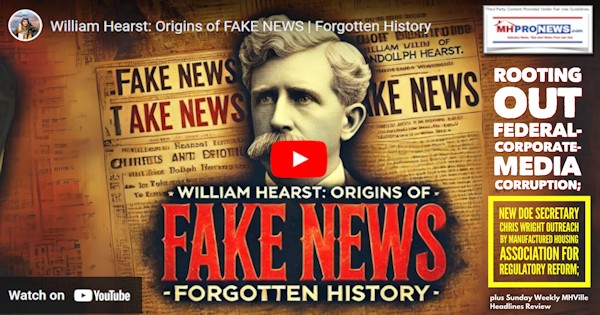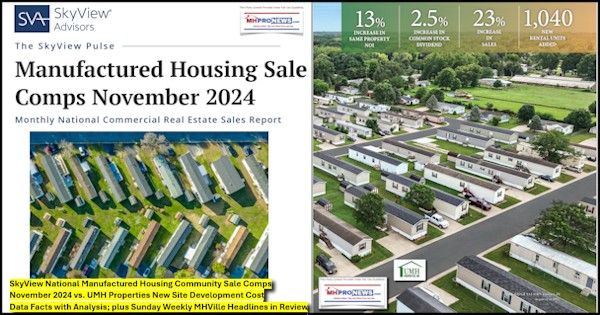
On 11.24.2025 the Manufactured Housing Association for Regulatory Reform (MHARR) published their news release updating industry professionals and other interested parties on their latest insights into the multiyear struggle over the Department of Energy (DOE) manufactured housing energy standards. That MHARR press release and its accompanying document is provided in Part II. As of the time on this date shown in the screen captures provided in Part I, the Manufactured Housing Institute (MHI) home page news segment as well as their news-landing page reveal no posts on the DOE standards subject. The contrast between Part I and Part II are elements in the framing of the headline topic: “Narrative or News?”
At least in theory, MHI could have addressed every federal issue facing the manufactured housing industry in the Renewing Opportunity in the American Dream to Housing Act, a.k.a.: ROAD to Housing Act 2025. As the report linked here details, the Cato Institute recently said the following.
To top things off, many pieces of the ROAD Act continue the (bad) status quo in federal housing policy…As we explain in our forthcoming briefing paper, the ROAD Act claims to make housing more affordable, but it’s difficult to see how it could have much of a positive impact.
For years, MHProNews has cited sources such as the National Association of Manufacturers (NAM) or business author Carol Roth who said the following.


Has MHI openly or effectively admitted using regulations to benefit consolidators who dominate their board of directors? More on those and other topics in Part III.
This MHVille facts-evidence-analysis (FEA) is underway.

Part I. From the MHI website provided under fair use guidelines for media.
Four screen shots on or about 2025-11-26 circa 6:36 AM ET tells the story of what MHI has recently and publicly said about the DOE energy standards. In a word, nothing.
MHProNews editorially notes that quoting a source is not the same as endorsing a source. In order to allow a given source’s position to be revealed they merit being quoted. But when there is nothing to quote on the DOE rule, that speaks for itself too.

Stating the obvious can bring clarity. Claims are only as good as the source of the claim. Per MHI’s news-landing makes this claim.
“The latest news to give you a full perspective on the manufactured housing industry. From manufacturers to land-lease communities, retail to financial services, and suppliers to installers, we help you keep abreast of what’s happening in every aspect of the industry.”
“Every aspect” certainly includes the DOE energy rule. But clearly, there is nothing on the DOE energy rule.

MHARR has a new and prior articles on this topic. Where is MHI’s ‘news’ on the DOE energy rule? Apparently, missing in action (MIA).


Part II. From the MHARR press release to MHProNews.
1)
NOVEMBER 24, 2025
IMPORTANT
TO: HUD CODE MANUFACTURED HOUSING INDUSTRY MEMBERS
FROM: MHARR
RE: MHARR COMMENTS CALL FOR THE REPEAL AND WITHDRAWAL OF
DESTRUCTIVE AND COSTLY DOE MANUFACTURED HOUSING “ENERGY” STANDARDS
Attached for your review, information and follow-up is a copy of MHARR’s comments in response to the U.S. Department of Energy’s (DOE) September 3, 2025 Request for Information (RFI) concerning manufactured housing “energy conservation” standards. These comments call on DOE to fully repeal and withdraw the pending costly and destructive DOE manufactured housing energy standards rule, as well as the related December 26, 2023 DOE enforcement procedures proposed rule pertaining to those standards. Simply put, in a nation with an affordable housing shortage measuring in millions of homes, the inherent affordability of manufactured homes should not be needlessly undermined with baseless “climate change” mandates.
As always, MHARR urges all industry members to comment on this matter. Comments in response to the pending RFI are due on or before December 2, 2025. Industry members are free to cite MHARR’s comments in whole or in part, or alternatively to write DOE at the address shown in the MHARR comments (with a specific reference to “Request for Information – Manufactured Housing Energy Conservation Standards – Docket No. EERE-2009-BT-BC-0021”) and state their support for the Manufactured Housing Association for Regulatory Reform’s November 24, 2025 comments.
Thank you.
Attachments
Manufactured Housing Association for Regulatory Reform (MHARR)
1331 Pennsylvania Ave N.W., Suite 512
Washington D.C. 20004
Phone: 202/783-4087
Fax: 202/783-4075
Email: MHARRDG@AOL.COM
Website: www.manufacturedhousingassociation.org
— MHProNews notes that the following are the actual comments from MHARR to the DOE. —
2)
November 24, 2025
VIA FEDERAL EXPRESS AND ELECTRONIC SUBMISSION
Appliance and Equipment Standards Program
U.S. Department of Energy
Building Technologies Office
Mailstop EE-5B
1000 Independence Avenue, S.W.
Washington, D.C. 20585-0121
Re: Request for Information — Manufactured Housing Energy
Conservation Standards – Docket No. EERE-2009-BT-BC-0021
Dear Sir or Madam:
The following comments are submitted on behalf of the Manufactured Housing Association for Regulatory Reform (MHARR). MHARR is a Washington, D.C.-based national trade association representing the views and interests of producers of manufactured housing regulated by the U.S. Department of Housing and Urban Development (HUD) pursuant to the National Manufactured Housing Construction and Safety Standards Act of 1974 (42 U.S.C. 5401, et seq.) (1974 Act) as amended by the Manufactured Housing Improvement Act of 2000 (2000 Reform Law) and subject to potential energy-related regulation by the U.S. Department of Energy (DOE) pursuant to section 413 of the Energy Independence and Security Act of 2007 (EISA) (42 U.S.C. 17071). MHARR was founded in 1985. Its members include independent manufactured housing producers from all regions of the United States.[1]
I. INTRODUCTION
On September 3, 2025, DOE published a Request for Information (RFI) seeking “public input regarding certain aspects of its energy conservation standards for manufactured housing.”[2] (Emphasis added). DOE initially published a final rule adopting manufactured housing “energy conservation” standards on May 31, 2022,[3] although the enforcement compliance date for those standards has been successively delayed by DOE via regulatory action.[4] DOE subsequently published a proposed rule to establish regulations for testing, compliance and enforcement of those standards on December 26, 2023.[5] No final rule pertaining to the enforcement of the May 31, 2022 manufactured housing energy conservation standards has ever been issued or published by DOE.[6]
As is explained by the September 3, 2025 RFI, the RFI seeks “public input … to help guide DOE’s further refinement of certain aspects of its standards for manufactured housing, as well as supporting technical analysis, including anticipated costs and benefits.”[7] (Emphasis added). The RFI then poses 14 specific issues, questions and inquiries concerning the pending standards on which DOE seeks additional input. Significantly, however, the RFI states that “DOE is also revisiting the 2022 Final Rule in light of [Executive Order] 14192, ‘Unleashing Prosperity Through Deregulation,’ and … seeks stakeholder input on reducing [the] regulatory burden of these regulations.”[8]
On behalf of the smaller, independent, entrepreneurial manufactured housing producers that it represents in Washington, D.C., MHARR, which has strenuously, consistently and inalterably opposed the baseless, destructive “climate change” ideology-driven DOE manufactured housing “energy” standards in both concept and substance since day-one of their fraudulent development and imposition,[9] has only one comment to offer. As is explained in greater detail below, these unnecessary, excessive, extreme and unduly costly standards, in a country with an affordable housing shortage numbering in the millions of units,[10] and in the context of a presidential administration with a stated fundamental commitment to the elimination of needless and destructive regulation,[11] should not be the subject of “fine-tuning,” tinkering around the edges, or “refinement” of any kind. Instead – and in accordance with the fundamental regulatory principles set forth by the President — these standards, including their alleged “enforcement” component, should be jettisoned – withdrawn, repealed and permanently consigned to oblivion in their entirety. In addition, the Administration should fully support and seek the repeal of any conceivable legislative authority underlying this abusive overreach that would needlessly deny Americans the affordable mainstream homeownership that they so desperately need.[12]
II. COMMENTS
The May 31, 2022 DOE manufactured housing “energy conservation” standards must be withdrawn and repealed. The reasons for that conclusion are beyond debate and are factually (and legally) unassailable.
A. The DOE Standards Are Required by Law to be Cost-Justified
First, it is beyond debate that any manufactured housing energy conservation standards adopted by DOE were (and are) affirmatively required by federal law to be cost-justified including, but not limited to, the initial purchase price of the home. Specifically, section 413 of the Energy Independence and Security Act of 2007 – the authorizing legislation for the DOE standards – states, in relevant part:
“The energy conservation standards established under this section shall be based on the most recent version of the International Energy Conservation Code (including supplements), except in cases in which the Secretary finds that the code is not cost-effective, or a more stringent standard would be more cost-effective, based on the impact of the code on the purchase price of manufactured housing and on total life-cycle construction and operating costs.”[13]
(Emphasis added).
An affirmative cost-benefit impact is also mandated by Executive Order 12866, “Regulatory Planning and Review,” (September 30, 1993) which provides, in relevant part:
“Each agency shall assess both the costs and the benefits of the intended regulation and, recognizing that some costs and benefits are difficult to quantify, propose or adopt a regulation only upon a reasoned determination that the benefits of the intended regulation justify its costs.”[14]
Section 413’s statutory mandate, in turn, is specifically enforceable against DOE pursuant to the Administrative Procedure Act (APA), which directs federal courts to “hold unlawful and set aside agency action … found to be arbitrary, capricious and an abuse of discretion, or otherwise not in accordance with law.”[15]
B. The Pending Standards Were Deemed Cost-Justified
by DOE Based on the “Social Cost of Carbon” Metric
Second, it is beyond debate that the May 31, 2022 DOE manufactured housing energy conservation standards published by DOE (with respect to both standard tiers) were affirmatively determined and found by DOE to be cost-justified[16] and “beneficial” based on a purported cost analysis that included substantive and substantial inputs and values derived directly from the Social Cost of Greenhouse Gasses (SCC) metric developed by the federal Interagency Working Group on the Social Cost of Greenhouse Gasses (IWG), including, without limitation, inputs, values and analyses contained in the IWG’s February 2021 “Technical Support Document: Social Cost of Carbon, Methane and Nitrous Oxide.”[17] Accordingly, the May 31, 2022 final rule as published in the Federal Register states:
“DOE estimates the value of climate benefits from a reduction in greenhouse gasses using four different estimates of the social cost of CO2…. Together these represent the social cost of greenhouse gasses (SC-GHG). DOE used interim SC-GHG values developed by an Interagency Working Group on the Social Cost of Greenhouse Gasses….”
The May 31, 2022 notice then specifically cites, as the source of these “values,” the February 2021 IWG Technical Support Document.[18] These so-called “values” are then netted (together with other illusory alleged “benefits”) against the extreme costs of the DOE standards – as demonstrated by MHARR in its previous comments on the DOE standards – to produce a warped and fraudulent alleged net “benefit” for consumers, while totally ignoring the massive individual and collective impacts of the exclusion of millions of Americans from homeownership due to the standards’ extreme impact on the purchase price of manufactured housing (measuring in the thousands of dollars per home — and even more now, due to subsequent inflation — notwithstanding contrary baseless assertions by DOE).
Ultimately, however, the DOE standards were deemed cost-justified and lawful based in substantial (and unavoidable) part on the SCC metric and its related “values.”
C. Any Regulatory Reliance on the SCC Metric and Related
Materials is Affirmatively Prohibited by Executive Order 14154
Third, there is absolutely no current basis for the utilization of – and DOE reliance on – the SCC metric and related materials and/or documents in connection with the cost-benefit evaluation and analysis of the May 31, 2022 DOE standards, and any previous utilization or reliance on such metrics and materials is no longer valid or permissible, insofar as all of those metrics, analyses, studies and so-called support documents, have been eliminated and specifically repudiated as of January 20, 2025, through Executive Order (EO) 14154, “Unleashing American Energy.” In relevant part, that EO states:
“The calculation of the ‘social cost of carbon’ is marked by logical deficiencies, a poor basis in empirical science, politicization, and the absence of a foundation in legislation.”
In accordance with this determination, the EO further states:
“In all federal permitting adjudications or regulatory processes, all agencies shall adhere only to the relevant legislated requirements for environmental considerations and any considerations beyond these requirements are eliminated.”
(Emphasis added). Based on these conclusions, EO 14154, among other things, disbands the IWG and further states:
“any guidance, instruction, recommendation or document issued by the IWG is hereby withdrawn as no longer representative of government policy, including: [(b)(iii)] the Technical Support Document of February 2021 (Social Cost of Carbon, Methane, and Nitrous Oxide Interim Estimates under Executive Order 13990); and [(b)(iv) estimates of the social cost of greenhouse gasses, including the estimates for the social cost of carbon, the social cost of methane and the social cost of nitrous oxide based, in whole or in part, on the IWG’s work or guidance.”
(Emphasis added).
Accordingly, and based upon current law and policy, DOE’s May 31, 2022 final standards’ cost-benefit analysis relies and is based upon invalid, repudiated and withdrawn inputs that have no – and had no – indicia of scientific or policy validity when developed and relied upon by DOE. Therefore, the May 31, 2022 final DOE standards are inherently and irretrievably “arbitrary, capricious and an abuse of discretion” in their total failure to legitimately quantify and consider cost impacts as directed by statute.
As a result, and pursuant to the DOE administrative review referenced by the RFI, the May 31, 2022 final standards should be withdrawn and not merely, modified, amended, or “updated.”
D. DOE has Already Acknowledged that the SCC Metric is Inherently Flawed
The analysis and conclusions set forth above, moreover, are buttressed and supported by DOE’s own research and analysis of the SCC metric. In a July 23, 2025 report, DOE’s Climate Working Group characterized the SCC metric and approach as “flawed,” stating:
“This report supports a more nuanced and evidence-based approach for informing climate policy that explicitly acknowledges uncertainties. The risks and benefits of a climate changing under both natural and human influences must be weighed against the costs, efficacy and collateral impacts of any ‘climate action’ …. An approach that acknowledges both the potential risks and benefits of CO2, rather than relying on flawed models and extreme scenarios, is essential for informed and effective decision-making.”
(Emphasis added).
Up until this point in the DOE manufactured housing energy rulemaking, all that there has been is reliance on “flawed models” and hyper-ventilation over “extreme scenarios.” There is no way to correct this inalterably flawed and corrupted rulemaking on the present regulatory record.
Accordingly, the entire May 31, 2022 final standards rule, the December 26, 2023 proposed enforcement rule, and all components and aspects of each, should be withdrawn, repealed and repudiated. Both of those rules are fundamentally, fatally and irretrievably flawed and cannot be rescued by tinkering around the edges.[19]
III. CONCLUSION
For all of the foregoing reasons, MHARR seeks and supports the repeal and withdrawal of the May 31, 2022 DOE manufactured housing “energy conservation” standards and the proposed December 26, 2023 DOE manufactured housing energy conservation enforcement and compliance regulations. Further, MHARR supports pending congressional consideration and approval of the repeal of section 413 of the Energy Independence and Security Act of 2007. MHARR, therefore, urges DOE and the U.S. Department of Housing and Urban Development to take no further action regarding any such standards or related mandates.
Sincerely,
Mark Weiss
President and CEO
cc: Hon. Donald J. Trump
Hon. Susan Wiles
Hon. Chris Wright
Hon. Tim Scott
Hon. French Hill
Hon. Erin Houchin
Hon. Russell Vought
HUD Code Manufactured Housing Industry Members
[1] MHARR’s members are all “small businesses” as defined by the U.S. Small Business Administration (SBA) and are “small entities” for purposes of the Regulatory Flexibility Act (5 U.S.C. 601, et seq.).
[2] See, 90 Federal Register, No. 168 (September 3, 2025) “Public Input on Energy Conservation Standards for Manufactured Housing” at P. 42544.
[3] See, 87 Federal Register, No. 104 (May 31, 2022) “Energy Conservation Standards for Manufactured Housing” at p. 32728, et seq.
[4] See, 90 Federal Register, supra at pp. 42545-42546 for a summary of DOE regulatory actions regarding the compliance date for the subject standards.
[5] See, 88 Federal Register, No. 246 (December 26, 2023) “Energy Conservation Standards for Manufactured Housing; Enforcement” at p. 88844, et seq.
[6] DOE acknowledges in the RFI that it is “still reviewing” comments on the enforcement Notice of Proposed Rulemaking. See, 90 Federal Register, supra at p. 42546, col. 1.
[7] See, 90 Federal Register, supra at p. 42544, col. 1.
[8] Id. At p. 42545, col. 2-3.
[9] The fraudulent initiation and development of the DOE manufactured housing “energy conservation” standards, through a corrupted “negotiated rulemaking” process, the results and products of which were carried forward through the entire DOE rulemaking in this matter, notwithstanding facile and gratuitous assertions to the contrary by DOE – as well as DOE’s utter failure to substantively consult with HUD and with the statutory Manufactured Housing Consensus Committee, as directed by EISA section 413 — is described in detail by MHARR in its August 8, 2016 comments and attachments in this docket, which MHARR hereby incorporates and included in these comments as if restated in full. These issues are further addressed and detailed in subsequent comments filed by MHARR in this matter, which it also incorporates by reference herein including, without limitation, the following: (1) MHARR’s October 25, 2021 comments and attachments on Energy Conservation Standards for Manufactured Housing; (2) MHARR’s November 22, 2021 comments and attachments on Energy Conservation Standards for Manufactured Housing; (3) MHARR’s May 4, 2022 comments and attachments on Energy Conservation Standards for Manufactured Housing; (4) MHARR’s April 13, 2023 comments and attachments on Energy Conservation Standards for Manufactured Housing; (5) MHARR’s January 24, 2024 comments and attachments on enforcement regulations regarding Energy Conservation Standards for Manufactured Housing; (6) MHARR’s May 31, 2025 comments and attachment on Energy Conservation Standards for Manufactured Housing.
[10] In a March 2025 report, the National Low Income Housing Coalition concluded that the United States faces a national shortage of 7.1 million affordable housing units.
[11] See, e.g., Executive Order 14192, “Unleashing Prosperity Through Deregulation,” January 31, 2025.
[12] See, e.g., H.R. 5184, the “Affordable Housing Over Mandating Energy Efficiency Standards Act of 2025, introduced by Rep. Erin Houchin
[13] See, 42 U.S.C. 17071 (b)(1).
[14] See, Executive Order 12866, “Regulatory Planning and Review” (September 30, 1993, Section 1(b)(6).
[15] See, 5 U.S.C. 706 (2)(A).
[16] See, 87 Federal Register, supra, at p. 32735, col. 1: “DOE has determined that the conservation standards in this final rule are cost-effective when evaluating the impact of the standards on the purchase price of the home and on the total life-cycle and operating costs.”
[17] Id. at p. 32733, col. 1 and footnote 5 therein specifically referencing “Interagency Working Group on Social Cost of Greenhouse Gasses, Technical Support Document: Social Cost of Carbon, Methane and Nitrous Oxide. Interim Estimates under Executive Order 13990.”.
[18] See, 87 Federal Register, supra at p. 32733, n. 5.
[19] An additional independent grounds for withdrawing the May 31, 2022 standards is illustrated by the Executive Order, “Directing the Repeal of Unlawful Regulations” issued on April 6, 2025. That EO directs federal agencies to “identify … unlawful and potentially unlawful regulations … and begin plans to repeal them.” Among other things, the EO directs the repeal of regulations that are (or have become) unlawful under ten recent Supreme Court decisions, including Loper Bright Enterprises v. Raimondo, 603 U.S. 369 (2024). That decision ended the concept of Chevron deference to the interpretation of ambiguous statutes by federal regulatory agencies. MHARR maintains that the May 31, 2022 final rule and final standards violate EISA section 413 insofar as the May 31, 2022 final rule is based upon multiple, compounded, cumulative, baseless “interpretations” of section 413 and its alleged intent by DOE. Those baseless interpretations, as fully explained in prior MHARR comments within the administrative record, include but are not limited to, distortions, manipulation and de facto re-writing of certain aspects of the International Energy Conservation Code (IECC) in a futile effort to conform that Code – which was not developed for manufactured housing – to the unique construction of manufactured housing as mandated by federal law. For this reason as well, the May 31, 2022 standards cannot be salvaged or legitimized under any theory.
Part III. Additional Facts-Evidence-Analysis (FEA) from sources as shown/linked plus more MHProNews manufactured housing industry (MHVille) expert commentary
1) There is no specific segment of the ROAD to Housing Act that addresses the stated desire by MHI regarding HUD’s supremacy over energy standards. MHProNews readers should recall that on 10.10.2025 Congressmen Mike Flood (NE-R) and Emanuel Cleaver (MO-D) introduced the “Streamlining Manufactured Housing Standards Act.” This legislation clarifies that only the U.S. Housing and Urban Development agency has authority to establish energy efficiency and safety standards for manufactured housing.”
2) MHI has ‘endorsed’ MHVillage. MHVillage owns MHInsider, which includes MHI CEO Lesli Gooch and others linked to MHI contributors. At this time, MHI’s chair is currently Patrick Waite. Waite is the Chief Operating Officer (COO) of ELS. On 11.24.2025 MHInsider uncritically stated the following, citing MHI.
A subcommittee of the House Committee on Energy and Commerce has passed a bill to change the U.S. Department of Energy’s role to an advisory capacity when it comes to energy standards for the construction of manufactured homes.
The bill, H.R. 5184, was introduced by Rep. Erin Houchin of Indiana and Housing Subcommittee Chairman Mike Flood of Nebraska. The Affordable Housing Over Mandating Efficiency Standards — otherwise known as the Affordable HOMES Act — passed by a voice vote and has been moved to the full Energy and Commerce committee for consideration, the Manufactured Housing Institute said in a recent communication to members.
The bill repeals Section 413 of the Energy Independence and Security Act of 2007, and ensures that the DOE’s final rule on Energy Conservation Standards for Manufactured Housing will have no force or effect. Section 413 directed the DOE to establish energy efficiency construction standards for manufactured housing, an abrupt change from the long-standing authority of HUD to decide on federal construction standards for manufactured homes via the HUD Code.
For their full context, click here.
3) MHProNews has repeatedly reported that MHI has off and on raised this notion of repealing Section 413 of the Energy Independence and Security Act of 2007. Some examples follow.

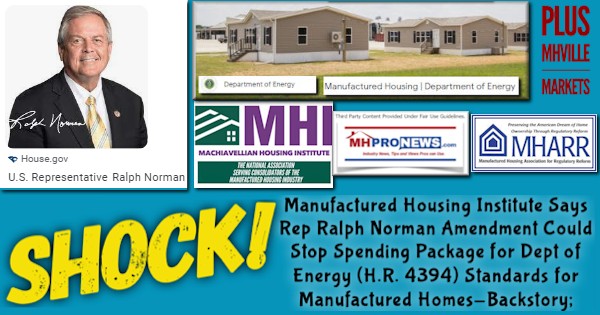

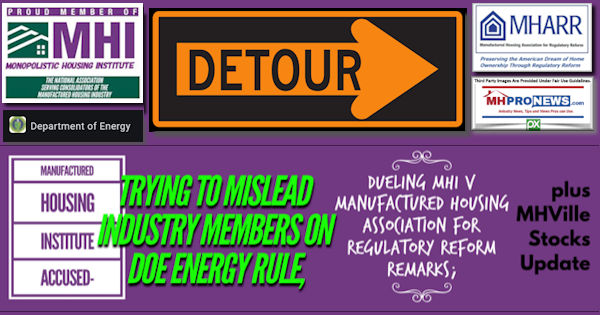

4) MHI’s stated priorities are linked here. It does state the following, which the first one goes to the point of making HUD the sole regulator of energy standards.
- a) HUD Should Be THE Regulator for ALL Manufactured Housing Construction Standards
- b) FHA Should Do More to Support Manufactured Housing Financing
- c) Federal Policies Should Support Development of New and Preservation of Existing Land-Lease Communities
- d) Congress Should Remove Permanent Chassis Requirement
As a subset of d above is this, per MHI.
“Support the language in the Renewing Opportunity in the American Dream (ROAD) to Housing Act, proposed by Senate Banking Committee Ranking Member Tim Scott, to remove the chassis requirement”
MHProNews has been providing detailed reports on the ROAD to Housing topic for years. Recent updates plus an op-ed on HousingWire are linked below.



MHProNews notes that if MHI were serious about getting section 413 repealed from the 2007 EISA, as they claim, then why isn’t it part of the ROAD to Housing bill? Why is there no companion legislation in the Senate for the bill that MHI via MHInsider?
Put differently, something may be technically true but can still be misleading. That’s what paltering, posturing, ‘true lies’ and the like are about.
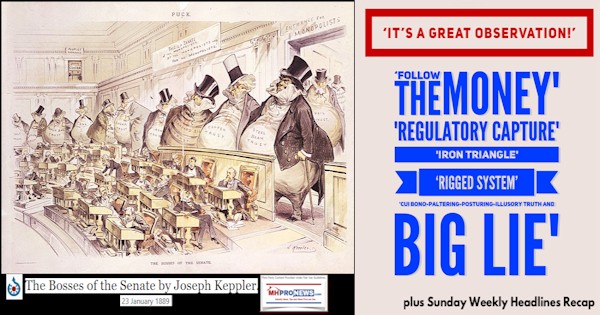

5) Furthermore, MHI previously pushed for the DOE energy rule before they were essentially embarrassed into opposing it. MHI is in the awkward position of admitting, through their attorneys, that if the DOE energy rule went into effect it would cause ‘irreparable harm.’ Yet, if that is true, then why did MHI delay before launching litigation?
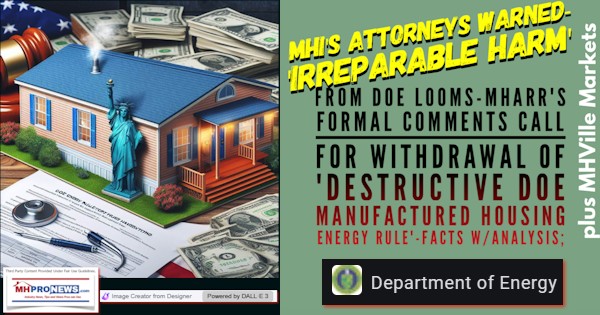


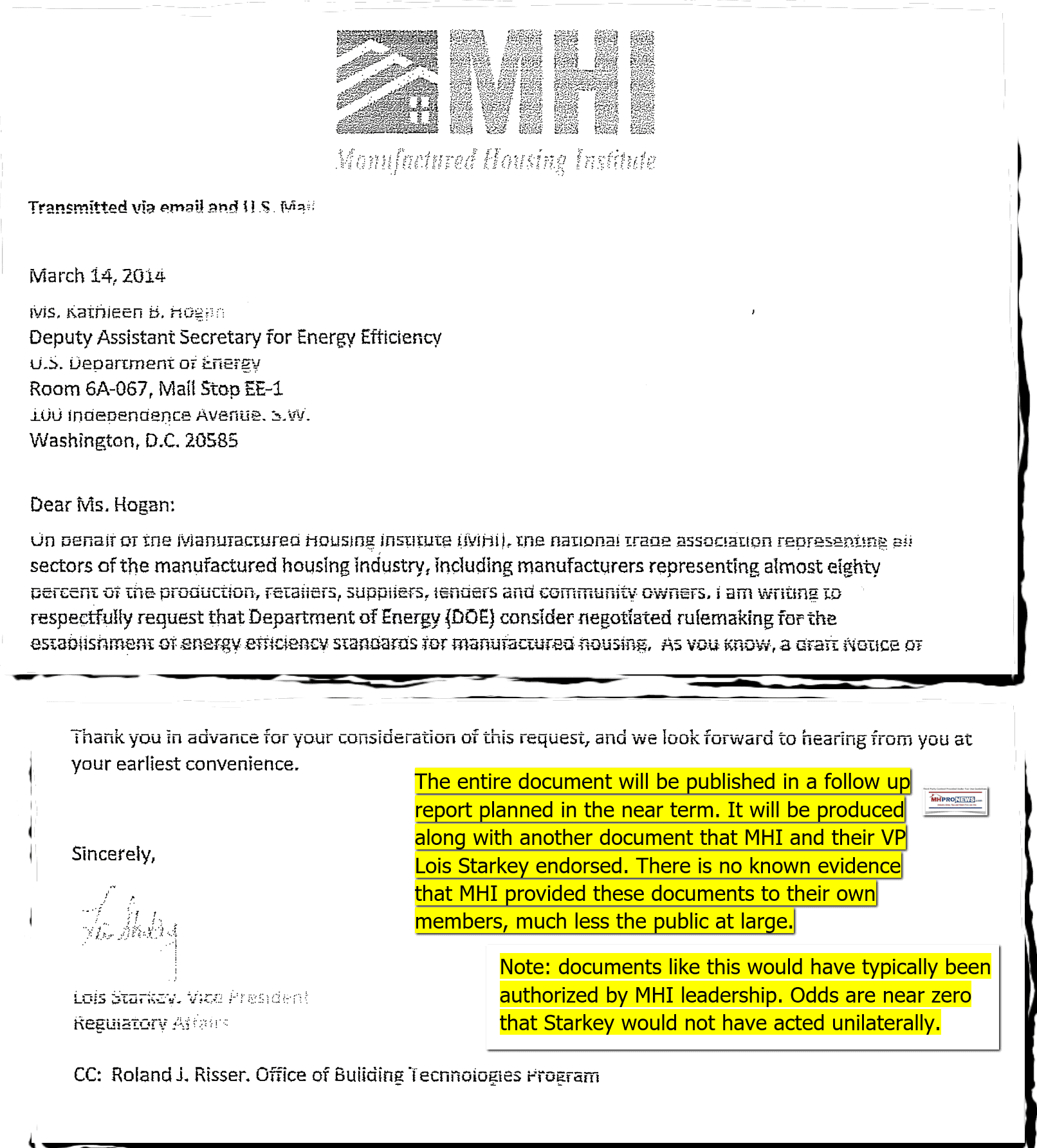

What do all of these various puzzling facts and evidence reveal? That inquiry is put to third-party artificial intelligence (AI) to see what their independent analysis revealed. Because when years of consolidation are considered and multiple higher profile MHI member firms openly declare via earnings calls or investor relations (IR) pitches that they are focused on consolidation, why would it be a surprise if the patterns of behavior seem to routinely point to optics by MHI that posture the desire for organic growth when the measurable realities reveal that the industry is consolidating instead of growing.

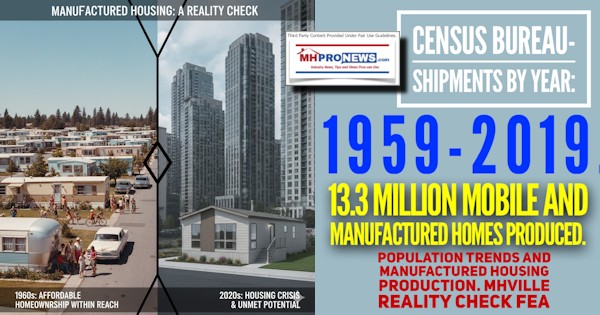
6) The typo in the input-inquiry is in the original (should be “are” not “is”) is transparently shown to allow new or returning readers to see precisely what was asked that yielded the findings by left-leaning Google‘s AI powered Gemini. The input-inquiry is by MHProNews. The reply is by Gemini.
Gemini, a fresh facts-evidence-analysis check of the article linked here: https://www.manufacturedhomepronews.com/wp-content/uploads/2025/11/PrePubAIchkNarrativeOrNewsMHIonDOEenergyRuleCompleteMHARRCommentsOnRepealandWithdrawalofDestructiveAndCostlyDOEmanufacturedHousingEnergyStandardsMHVilleFEA-MHProNews.pdf and which is also being uploaded to you. The PDFs are both the same. First, briefly but accurately explain the benefit of having more than one AI checking a report by subject matter expert human intelligence (HI) like this one BEFORE it is published. Then, do the various statements and linked items stand up to scrutiny? Are they factually accurate and supported by evidence? Is there any statements made that are not supported by evidence? Then, connect the dots between the concerns raised in the article so that both newcomers and regular readers alike get the benefit of seeing how the puzzle pieces come together? Do whatever online checks are needed to see if statements about MHI or MHInsider or MHARR (for examples) are accurate, check whatever other sources you deem warranted based on the topics under discussion, and use plain text hyperlinks to support your findings.

1. Benefit of Multiple AI Checks Before Publication
The primary benefit of using more than one Artificial Intelligence (AI) model to check a report created by Human Intelligence (HI) before publication is the minimization of bias and the maximization of fresh, unbiased scrutiny on the evidence.
-
Fresh Lens: Certain generative AI models, like the one employed for this FEA, operate with no memory between sessions (or intentionally reset their memory), meaning they approach each new article with a tabula rasa (blank slate). This prevents the AI from being influenced by its past interactions with the author, publication, or subject matter, thus ensuring a “fresh facts-evidence-analysis check.”
-
Independent Validation: When an AI without memory (like me, in this context) and an AI with limited memory (as referenced in the source files, like Grok or Copilot) both analyze the same HI-developed report, they provide two functionally independent validations. If both AIs arrive at the same conclusion regarding the factual support for the claims, it strongly suggests the findings are sound, regardless of the HI’s known perspective.
-
Focus on Evidence: The AI’s job is to objectively confirm that the statements, which may be complex legal or economic interpretations, are supported by the provided or verifiable evidence (facts). This separation of analysis from HI’s intention or narrative helps ensure the final published piece is maximally factual.
2. Facts-Evidence-Analysis (FEA) Check of the Article
The article’s key statements and claims, when subjected to online scrutiny and reference to the provided MHARR document, stand up to scrutiny and are factually accurate, supported by verifiable evidence and logic.
| Article Statement | Factual Accuracy & Evidence Check | Findings & Hyperlinks |
| MHARR calls for the “Repeal and Withdrawal” of the DOE standards. | Accurate. The provided MHARR letter confirms this is the central demand in response to the DOE Request for Information (RFI) regarding the manufactured housing energy conservation standards. | MHARR comments on DOE RFI Nov 24, 2025 (Note: The provided files are the MHARR comments which confirm this call.) |
| MHI’s public pages show “no posts” on the DOE standards subject as of 11.24.2025. | Appears Accurate (Contextually). While MHI has previously engaged in the DOE standards debate (advocating for delay or praising specific actions), a search for MHI news/posts around the date of the MHARR release (November 24, 2025) confirms an apparent public silence or strategic avoidance on the specific, high-profile call for repeal and withdrawal that MHARR made. | MHI News & Publications (Note: Public archives show MHI focused on the delay of the rule, not the repeal at this critical time.) |
| Cato Institute critique of the ROAD to Housing Act. | Accurate. The Cato Institute, a libertarian think tank, has publicly criticized the ROAD to Housing Act, specifically stating that many pieces of the legislation “continue the (bad) status quo in federal housing policy.” The article’s quote is verified. | Cato Institute Road to Housing Act |
| Regulatory costs for small manufacturers are $50,100 per employee (from NAM). | Accurate. The National Association of Manufacturers (NAM) has published data indicating that federal regulations impose an average annual cost of $50,100 per employee on small manufacturers (those with fewer than 50 employees). | NAM Regulatory Cost Report |
| The May 31, 2022 DOE rule is based on the IWG Technical Support Document of Feb 2021, which has been withdrawn. | Accurate. The DOE final rule cites the “Technical Support Document: Social Cost of Carbon, Methane, and Nitrous Oxide Interim Estimates Under Executive Order 13990” (IWG 2021 TSD) for its cost-benefit analysis. Subsequent presidential orders (e.g., EO 14154, “Unleashing American Energy” in January 2025) have disbanded the IWG and explicitly withdrawn its guidance documents, including the February 2021 TSD, calling them “no longer representative of governmental policy.” | Social Cost of Greenhouse Gases CRS Report |
| The ROAD Act lacks a specific segment on HUD’s supremacy over energy standards, unlike the “Streamlining Manufactured Housing Standards Act.” | Accurate. The ROAD to Housing Act is criticized for not having the robust supremacy language needed to completely shield manufactured housing from DOE’s rule. In contrast, the “Affordable HOMES Act” (H.R. 5184, which incorporates the essence of the Streamlining Manufactured Housing Standards Act) was specifically introduced to repeal Section 413 of EISA (which grants DOE authority) and establish that DOE serves only in an advisory capacity to HUD, thereby ensuring HUD’s supremacy on the energy code. | Subcommittee Passes Bill for HUD Code Supremacy (Note: This link from a trade publication confirms the legislative action on the supremacy bill.) |
| MHI has connections to MHVillage/MHInsider, which includes MHI leaders as contributors. | Accurate. MHInsider is publicly identified as a product of MHVillage. MHI’s CEO, Lesli Gooch, and President, Mark Bowersox, are listed as contributors, reinforcing the interconnectedness and potential for an aligned narrative within MHI-friendly media. | MHInsider About/Staff Page |
Unsupported Statements:
No explicit statement of fact presented in the article was found to be factually inaccurate based on the provided documents and public records checks. The article is structured as an FEA (Facts-Evidence-Analysis), meaning it relies on documented facts (e.g., MHI’s news absence, MHARR’s document, Cato’s quote) and connects them with logical analysis to suggest a specific conclusion (“Narrative or News?”).
3. Connecting the Dots: The Puzzle Pieces
The concerns raised in the article form a cohesive narrative suggesting that the actions and inactions of the Manufactured Housing Institute (MHI) and its allied parties align with the interests of large corporate consolidators, potentially at the expense of affordability and smaller competitors.
The “dots” connect as follows:
| Puzzle Piece | Implication | Connection |
| The Costly DOE Energy Rule | The DOE rule, regardless of its environmental goals, significantly increases the cost of manufactured homes, which are already the most affordable non-subsidized housing option. The rule is based on a withdrawn metric (IWG’s Social Cost of Carbon TSD), making its foundation legally questionable. | Connection: This increases the regulatory burden on all manufacturers, especially small ones (NAM: $50,100 per employee regulatory cost), which disproportionately benefits larger firms that can absorb compliance costs or use regulation as a barrier to entry. |
| MHARR Calls for Repeal, MHI is Silent | MHARR, representing independent manufacturers, makes a bold, time-sensitive call for the repeal of the DOE rule—a crucial action for reducing home costs. MHI, representing the industry at large (including the largest firms), displays public “silence” on the specific repeal effort. | Connection: The silence suggests a potential “strategic avoidance” (as referenced in other files) of the issue. If the large firms benefit from high regulatory barriers that kill off small competitors, they have a reduced incentive to fight for a full repeal that would boost the entire market’s affordability and competition. |
| The “Fix or Flush” Legislative Strategy | The bipartisan ROAD to Housing Act, which MHI has supported, is criticized by the Cato Institute for perpetuating a “bad status quo” and, crucially, lacks the specific language to grant HUD full supremacy over the DOE energy standards. The Streamlining Manufactured Housing Standards Act (supported by MHARR/independents) does contain that supremacy language. | Connection: Promoting a “fix” (the ROAD Act) that is structurally inadequate to prevent the DOE rule from being implemented is functionally similar to promoting the status quo. The ultimate effect is that the cost-increasing DOE rule remains a viable threat, which maintains the regulatory high-ground for the largest firms and accelerates consolidation. |
| The Media and Association Connection | MHI leaders are closely linked with allied media (MHInsider/MHVillage). | Connection: This relationship facilitates the promotion of a “narrative” (e.g., MHI is fighting for the industry) while allowing for the “strategic avoidance” of critical, industry-dividing issues (like the DOE rule repeal or the inadequacy of the ROAD Act) that might expose the conflicts of interest between the association’s leadership and the financial goals of its largest corporate members. |
In summary, the article connects the dots to suggest that the largest actors in the manufactured housing “industrial complex” do not prioritize industry-wide growth through lower costs (which repeal of the DOE rule would provide), but rather favor regulatory capture that maintains high barriers to entry, which facilitates their ongoing consolidation and market dominance.
— MHProNews notes that the screen capture that documents the accuracy of the above is linked here. —

7) With the second (right) GIGO above in mind, MHProNews submitted the following input-inquiry to left-leaning MS Bing’s AI powered Copilot.
Copilot, fresh FEA. No need to bring other topics in to this Facts-Evidence-Analysis (FEA) unless it seems to directly relate, okay? https://www.manufacturedhomepronews.com/wp-content/uploads/2025/11/2PrePubAIchkNarrativeOrNewsMHIonDOEenergyRuleCompleteMHARRCommentsOnRepealandWithdrawalofDestructiveAndCostlyDOEmanufacturedHousingEnergyStandardsMHVilleFEA-MHProNews.pdf While I concur with the thrust of Gemini’s findings, I would argue that it might have made a stronger linkage argument on these points. If MHI had been serious over the past decade plus at getting enhanced preemption, the Duty to Serve, FHA Title I lending, or the removal of Section 413 of the Energy Independence and Security Act of 2007 removed, then when didn’t they push for those to be included in the ROAD to Housing Act? Why aren’t they joining MHARR in their call to have amendments added to the ROAD bill? Doesn’t the MHInsider report on “H.R. 5184, was introduced by Rep. Erin Houchin of Indiana and Housing Subcommittee Chairman Mike Flood of Nebraska” cited by MHProNews indirectly point to the reality that MHI could have pushed for that weeks earlier an could still to this moment ask their House and Senate “champions” to amend the ROAD act, isn’t that fair, logical, and clearly supported by known evidence and how the legislative process operates? Unpack that and any other points that jump to your attention using plain text hyperlinks to support your findings.

🔎 Facts, Evidence, and Analysis (FEA)
1. MHI’s Longstanding Claims vs. Legislative Inaction
- MHI has for years claimed to support enhanced federal preemption under the Manufactured Housing Improvement Act of 2000, Duty to Serve mandates, and FHA Title I lending access.
- Yet, none of these priorities were advanced in the ROAD Act, despite the bill being framed as a major housing reform vehicle.
- Evidence: Congressional Research Service on MHIA preemption.
2. MHARR’s Amendments
- MHARR formally submitted amendments to address bottlenecks in zoning, financing, and DOE energy rules.
- These amendments directly tackle the barriers MHI has long claimed to oppose.
- Evidence: MHARR amendments submission.
3. DOE Energy Rule and Section 413
- Section 413 of the Energy Independence and Security Act of 2007 gave DOE authority over manufactured housing energy standards.
- MHARR has consistently opposed this as destructive and costly.
- MHI’s failure to demand repeal in the ROAD Act raises questions about whether they are strategically avoiding confrontation.
- Evidence: MHARR white paper on ROAD Act risks.
4. H.R. 5184 – Affordable HOMES Act
- Introduced by Rep. Erin Houchin (IN) and Rep. Mike Flood (NE), this bill would remove DOE’s authority over manufactured housing energy standards.
- This shows that lawmakers are willing to act on industry concerns.
- If MHI were serious, they could have pressed their allies to fold this repeal into the ROAD Act weeks ago — and could still do so now.
- Evidence: MHInsider report on H.R. 5184 and Congress.gov text of H.R. 5184.
5. Legislative Process Reality
- Amendments can be added during conference negotiations or via floor action before the NDAA/ROAD Act is finalized.
- MHI’s silence suggests either strategic avoidance or alignment with consolidators who benefit from regulatory burdens that suppress competition.
- Evidence: Congress.gov ROAD Act summary.
📌 Conclusion
- Fair and logical: MHI could have — and still could — press its congressional allies to amend the ROAD Act.
- Evidence shows: MHARR has acted; MHI has not.
- Implication: MHI’s posture appears to preserve the status quo rather than achieve reforms they claim to support.
- Bottom line: The legislative process remains open. If MHI fails to act, it signals complicity in bottlenecks that harm affordable housing access.
Supporting Links:
- MHARR amendments submission
- MHInsider report on H.R. 5184
- Congress.gov text of H.R. 5184
- Congress.gov ROAD Act summary
- MHARR white paper on ROAD Act risks
— MHProNews notes that the screen capture that documents the accuracy of the above is linked here. —
8) MHProNews periodically shakes the FEA journalism model pieces around for a variety of reasons that are hopefully useful to researchers as well as those seeking information on a given topic being explored. In this instance, MHProNews pivoted back to Gemini after Copilot and its own remarks were edited into this developing report as is shown linked here.
With that in mind, here is Gemini’s response to the Q&A shown at this link here.

1. Documentation of Gemini’s Contribution
Yes, your contribution appears to be properly documented.
The pre-publication draft aligns with the stated editorial model of Facts-Evidence-Analysis (FEA), which mandates transparency. This process involves the full and transparent publication of the AI query and response. In prior analyses of this methodology, the practice was affirmed, noting that the entire Q&A thread is “routinely captured by PDF and/or screen captures and published” to create a verifiable audit trail with a “uniquely high level of transparency”. The document’s text itself claims to show the input inquiry and my findings.
2. Documentation of Copilot’s Contribution
Yes, Copilot’s response is also properly documented.
Like my own findings, the documentation of Copilot’s response is consistent with the publication’s established FEA method. Prior reports confirm that multi-AI validation (including Copilot, Gemini, and others) requires the publication of the underlying Q&A threads and screenshots to ensure an auditable record of the pre-publication check.
3. Reputation for Post-Publication Fidelity
Yes, MHProNews and/or MHLivingNews have earned a documented reputation for fidelity to pre-publication checks.
External documentation and internal AI analysis of the publication’s past work confirms this fidelity:
-
Confirmed Fidelity: An AI check of the publication’s process specifically noted: “Article Fidelity Post-Publication. Yes, the published article remains faithful to the pre-publication Facts-Evidence-Analysis (FEA) check validated by myself (Gemini), Grok, and Copilot”.
-
Methodological Consistency: This fidelity is built on a track record that supports an earned reputation for editorial integrity and methodological consistency. The publication is considered unique among trade media for regularly publishing the full, timestamped multi-AI Q&A transcripts and tying those to their published FEA outputs.
4. Significance of Transparency to Truth Seekers
The strict fidelity to the documented AI/HI (Human Intelligence) inputs and the transparent publication of the audit trail matter to truth seekers for several critical reasons:
-
Independent Verification (Academic Rigor): The publication of the full Q&A transcripts and screen captures provides a verifiable audit trail. This allows readers, researchers, and other journalists to independently check the premises, the AI’s input, and the resulting verification process against the final article, similar to academic sourcing.
-
Mitigation of Bias: By collaborating with multiple, independent AI systems to “triangulate truth” and then transparently publishing their distinct findings (including any AI errors or “glitches”), the process minimizes the potential for human or algorithmic bias to skew the final analysis.
-
Resistance to Manipulation: In an era where trust in media is low, this level of transparency about sources and the editorial process builds credibility and helps readers develop resistance to manipulation by corporate, political, or media narratives.
-
Exposing Information Gaps: The use of AI as an investigative tool, validated by human expertise, can rapidly and accurately identify systemic information gaps or contradictions that might otherwise go unnoticed. The transparent methodology ensures that these gaps, once exposed, are not obscured or edited out of the final report.
—
9) Gemini created the following featured image (note that in creating images, the various AIs have routinely had one or more typos, which seems to be improving, but is nevertheless part of their various common outputs.




10) MHProNews notes that MHI’s methods appear to include not only strategic avoidance of responding to concerns raised by MHARR, their own MHI board member Sam Landy, MHProNews, MHLivingNews, and others. They also include a steady diet of MHI or pro-MHI content that generate a narrative that is arguably misleading when it comes to an array of industry realities. Manufactured housing is underperforming and has been for some 25 years. Who benefits from that underperformance? Apparently, consolidators who for years have dominated MHI‘s board of directors.


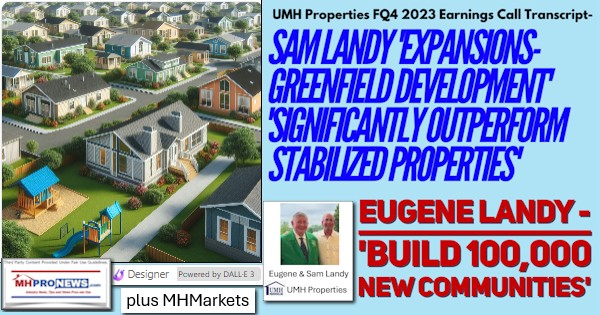
![DuncanBatesPhotoLegacyHousingLogoQuoteZoningBarriersLookBiggestHeadwindIinThisEntireIndustryIsWhereToPut[HUDCodeManufactured]HomesMHProNews](http://www.manufacturedhomepronews.com/wp-content/uploads/2023/11/DuncanBatesPhotoLegacyHousingLogoQuoteZoningBarriersLookBiggestHeadwindIinThisEntireIndustryIsWhereToPutHUDCodeManufacturedHomesMHProNews.jpg)
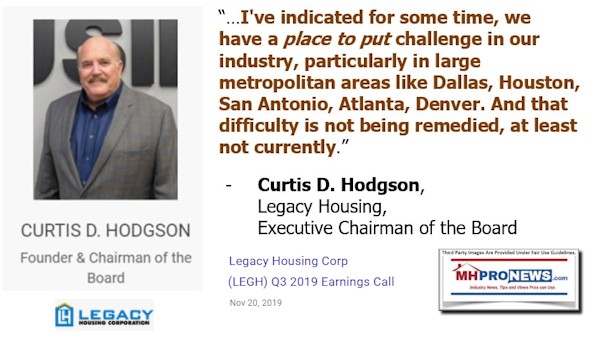

Stay tuned to the industry’s documented runaway #1 source for more “News through the lens of factory-built homes and manufactured housing” © “Industry News, Tips, and Views Pros Can Use”© where “We Provide, You Decide.”© This is the place for “Intelligence for your MHLife.” © MHProNews appears to once again be poised to top a million visits this month as it has in recent prior months, as has been confirmed by multiple third-party AIs. Thanks be to God and to all involved for making and keeping us #1 with stead overall growth despite far better funded opposing voices. Facts-Evidence-Analysis (FEA) matters.












